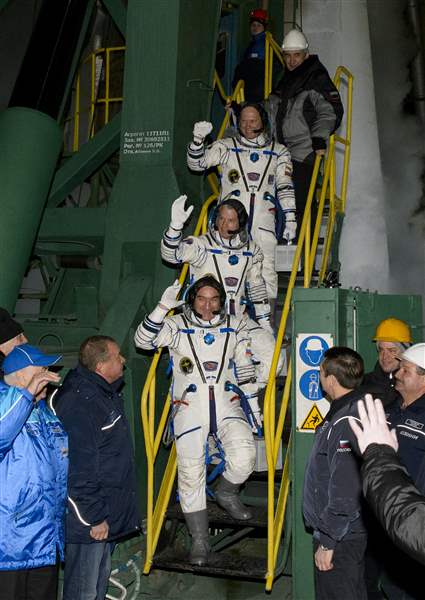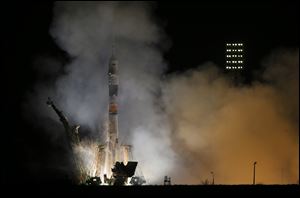
Space station arrival delayed for U.S.-Russian crew
3/26/2014
Expedition 39 Soyuz commander Aleksander Skvortsov, of the Russian Federal Space Agency (Roscosmos), followed by, flight engineer Steve Swanson of NASA, middle, and flight engineer Oleg Artemyev of Roscosmos, wave farewell prior to boarding the Soyuz rocket today.
ASSOCIATED PRESS

The Soyuz-FG rocket booster with Soyuz TMA-12M space ship carrying a new crew to the International Space Station blasts off at the Russian leased Baikonur cosmodrome, Kazakhstan, today. The Russian rocket carries astronaut Steven Swanson, Russian cosmonauts Alexander Skvortsov and Oleg Artemyev.
MOSCOW — A software glitch on a Russian spacecraft heading to the International Space Station has delayed the arrival of three astronauts, including an American. NASA said the crew was in no danger, and the U.S.-Russia space partnership was strong despite tensions over Ukraine.
The Soyuz spacecraft carrying Russians Alexander Skvortsov and Oleg Artemyev and NASA’s Steve Swanson blasted off successfully early today and was scheduled to dock six hours later. But because of the glitch, the arrival was pushed back until late Thursday.
Since the retirement of the U.S. space shuttle fleet in 2011, NASA has depended on the Russian spacecraft to ferry crews to the orbiting outpost and is paying Russia nearly $71 million per seat. This cooperation has continued despite tensions over Russia’s annexation of Crimea and U.S. calls for harsher sanctions on Russia.

Expedition 39 Soyuz commander Aleksander Skvortsov, of the Russian Federal Space Agency (Roscosmos), followed by, flight engineer Steve Swanson of NASA, middle, and flight engineer Oleg Artemyev of Roscosmos, wave farewell prior to boarding the Soyuz rocket today.
NASA Administrator Charles Bolden repeatedly has said that the conflict in Ukraine would have no effect on the U.S.-Russian partnership. As recently as Tuesday he reiterated on his blog that while NASA continues to cooperate successfully with Russia, it wants to get its own capacity to launch crews as quickly as possible. NASA is trying to speed up private American companies’ efforts to launch crews into orbit, but it needs extra funding.
The Soyuz booster rocket lifted off as scheduled at 3:17 a.m. local time today from the Russian-leased Baikonur cosmodrome in Kazakhstan. It entered a designated orbit about 10 minutes after the launch and was expected to reach the space station in six hours. All onboard systems were working flawlessly, and the crew was feeling fine.
NASA and Roscosmos, Russia’s space agency, said shortly before the planned docking that the arrival had been delayed after a 24-second engine burn that was necessary to adjust the Soyuz spacecraft’s orbiting path “did not occur as planned.”
The crew is in no danger, but will have to wait until Thursday for the Soyuz TMA-12M to arrive and dock at the space station, NASA said. The arrival is now scheduled for 7:58 p.m. EDT (2358 GMT) Thursday.
Roscosmos chief Oleg Ostapenko said today that the glitch occurred because of a failure of the ship’s orientation system. The crew is in good spirits and they have taken off their space suits to prepare for the long flight, Ostapenko said in remarks carried by Russian news agencies.
The Russian official said the crew is now working to adjust the spacecraft to the correct orbit for the Thursday docking.
Until last year, Russian spacecraft used to routinely travel two days to reach the orbiting laboratory. Today would have been only the fifth time that a crew would have taken the six-hour “fast-track” route to the station.